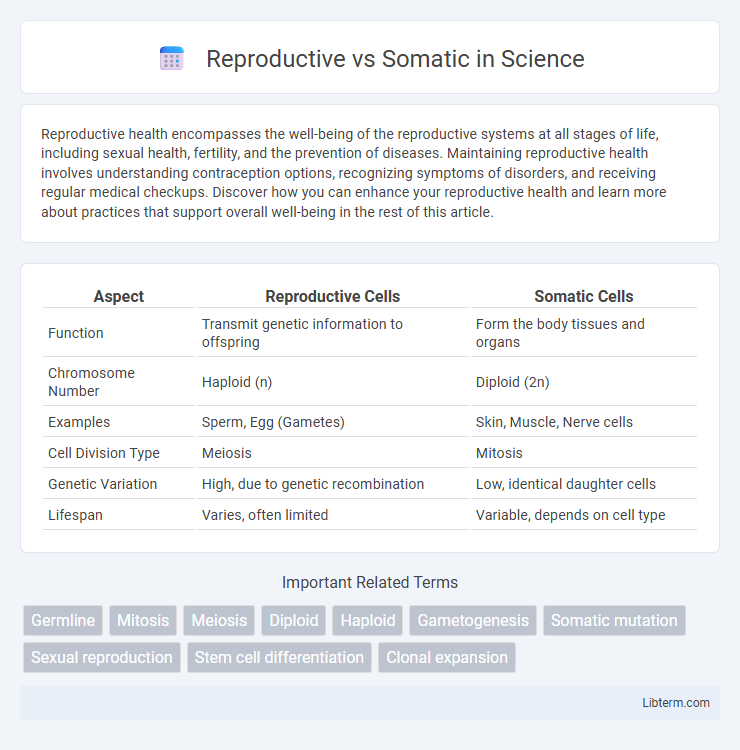Reproductive health encompasses the well-being of the reproductive systems at all stages of life, including sexual health, fertility, and the prevention of diseases. Maintaining reproductive health involves understanding contraception options, recognizing symptoms of disorders, and receiving regular medical checkups. Discover how you can enhance your reproductive health and learn more about practices that support overall well-being in the rest of this article.
Table of Comparison
| Aspect | Reproductive Cells | Somatic Cells |
|---|---|---|
| Function | Transmit genetic information to offspring | Form the body tissues and organs |
| Chromosome Number | Haploid (n) | Diploid (2n) |
| Examples | Sperm, Egg (Gametes) | Skin, Muscle, Nerve cells |
| Cell Division Type | Meiosis | Mitosis |
| Genetic Variation | High, due to genetic recombination | Low, identical daughter cells |
| Lifespan | Varies, often limited | Variable, depends on cell type |
Introduction to Reproductive and Somatic Cells
Reproductive cells, also known as gametes, are haploid cells responsible for sexual reproduction and carry half the genetic material needed to form offspring. Somatic cells are diploid, containing two sets of chromosomes, and make up the body's tissues and organs for growth, development, and maintenance. The fundamental difference lies in their roles: reproductive cells contribute to genetic diversity through fertilization, while somatic cells support the organism's structure and function.
Definition and Key Differences
Reproductive cells, also known as germ cells, are specialized cells that carry genetic information to offspring through gametes such as sperm and eggs, enabling sexual reproduction. Somatic cells constitute all other cells in the body, responsible for forming tissues and organs and maintaining physiological functions without contributing directly to genetic inheritance. The key difference lies in their purpose: reproductive cells transmit hereditary information to the next generation, whereas somatic cells support the organism's growth, development, and maintenance.
Genetic Composition: Reproductive vs Somatic
Reproductive cells carry a haploid set of chromosomes, containing half the genetic material necessary for offspring, enabling genetic diversity through meiosis. Somatic cells possess a diploid set of chromosomes, maintaining the complete genetic blueprint necessary for normal body function and tissue maintenance. This fundamental difference in chromosome number and genetic content underpins the unique roles of reproductive and somatic cells in biology.
Functions of Reproductive Cells
Reproductive cells, or gametes, function to transmit genetic information to offspring, ensuring species continuation through sexual reproduction. These cells undergo meiosis, reducing the chromosome number by half to maintain genetic stability across generations. Unlike somatic cells, which support bodily functions and growth, reproductive cells specialize in fertilization and genetic diversity.
Functions of Somatic Cells
Somatic cells are responsible for forming the body's tissues and organs, enabling growth, repair, and maintenance of the organism. They facilitate vital physiological functions by differentiating into various cell types such as muscle, nerve, and skin cells. Unlike reproductive cells, somatic cells do not participate in heredity and maintain genetic stability through mitotic division.
Cellular Division: Mitosis and Meiosis
Reproductive cells undergo meiosis, a specialized cellular division resulting in four genetically diverse haploid gametes, essential for sexual reproduction and genetic variation. Somatic cells divide through mitosis, producing two identical diploid daughter cells for growth, tissue repair, and cellular maintenance. Meiosis includes two division stages--meiosis I and meiosis II--leading to reductional and equational division, whereas mitosis consists of a single division cycle producing genetically identical cells.
Role in Inheritance and Variation
Reproductive cells, or gametes, carry half the genetic information and are essential for passing genetic material to offspring, directly influencing inheritance and contributing to genetic variation through processes like meiosis and fertilization. Somatic cells contain the full set of chromosomes but do not contribute to inheritance, as they are involved in growth, repair, and maintenance of the organism without transmitting genetic changes to the next generation. Genetic variation arises primarily from mutations and recombination in reproductive cells, whereas somatic mutations affect only the individual and are not inherited.
Mutations in Reproductive vs Somatic Cells
Mutations in reproductive cells, or germline mutations, are heritable and can be passed to offspring, affecting every cell in the resulting organism. Somatic mutations occur in non-reproductive cells, impacting only the individual and often leading to diseases such as cancer without inheritance. Understanding the distinction between germline and somatic mutations is crucial for genetic counseling, disease risk assessment, and targeted therapies.
Medical and Biological Implications
Reproductive cells, or gametes, carry half the genetic information necessary for sexual reproduction and play a crucial role in hereditary transmission and genetic diversity, making their integrity vital in reproductive medicine and genetic counseling. Somatic cells constitute the body's tissues and organs, with mutations in these cells often leading to diseases such as cancer, highlighting the importance of somatic cell research in oncology and regenerative medicine. Understanding the differences between reproductive and somatic cells informs treatments ranging from fertility interventions to targeted cancer therapies, emphasizing the medical and biological implications of cell type-specific functions and mutations.
Conclusion: Importance in Human Biology
Reproductive cells carry genetic information to offspring, ensuring species survival through heredity, while somatic cells maintain body functions and structure by enabling growth, repair, and cellular activities. The distinction emphasizes genetic continuity versus individual organism maintenance in human biology. Understanding these roles clarifies fundamental processes like development, disease mechanisms, and inheritance patterns.
Reproductive Infographic

 libterm.com
libterm.com